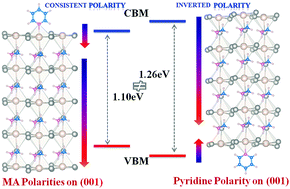The electronic properties of CH3NH3PbI3 perovskite surfaces tuned by inverted polarities of pyridine and ethylamine†
Abstract
Lead (Pb)-based halide perovskites with enhanced solar cell performance and a larger open-circuit voltage were experimentally observed after the treatment of crystal surfaces with pyridine and amine-functionalized molecules. We model the Pb–I2 terminated perovskite surfaces using density-functional theory and find that two small organic molecules, pyridine and ethylamine, interact with the surfaces and tune their electronic band gaps. When dopants on surfaces have parallel or antiparallel polarities with the orientation of methylammonium (MA = CH3NH3) molecules in bulk, the electronic properties of the perovskite surfaces will be remarkably different. We demonstrate that ethylamine and pyridine with antiparallel polarities can enlarge the band gaps of perovskite surfaces. The change of electronic properties is ascribed to the cancellation of the dipole moments caused by the pyridine/ethylamine and methylammonium molecules on surfaces. We further vary the polarities of MA molecules by interchanging the C and N atoms in a symmetric fashion for showing the influence of polarization on total energies, electronic properties and charge distributions.



 Please wait while we load your content...
Please wait while we load your content...